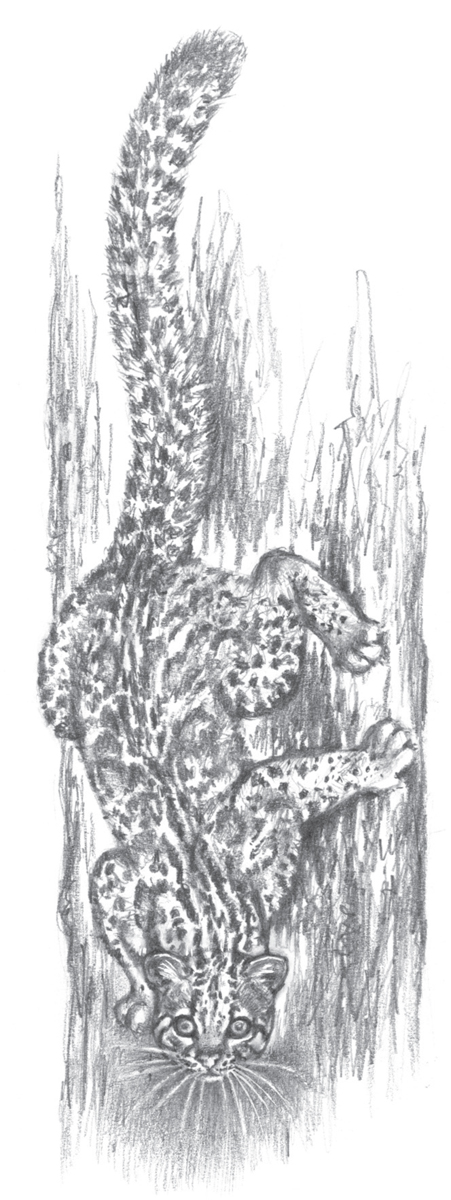
Marbled Cat
Pardofelis marmorata (Martin, 1837)


 IUCN RED LIST (2008): Vulnerable
IUCN RED LIST (2008): Vulnerable
Head-body length 45−62cm
Tail 35.6−53.5cm
Weight 2.5−5 kg
Taxonomy and phylogeny
The Marbled Cat was once considered a close relative of the Clouded Leopard based on superficial morphological similarities including the heavily blotched pelage, elongated tail, oversized feet and enlarged dentition. Genetic analyses show conclusively the species belongs in the Pardofelis lineage with the Bay Cat and Asiatic Golden Cat. These latter two species are more closely related to each other than either is to the Marbled Cat, which is classified in its own genus. There is increasing evidence that Marbled Cat populations on the mainland and on Sumatra and Borneo are actually two separate, closely related species (as for mainland and Sunda Clouded Leopards).
Description
The Marbled Cat is the size of a large, long-bodied domestic cat covered with dense, soft fur that gives an overall larger appearance and with an extremely long, thickly furred tail. The tail is very long, sometimes exceeding the head-body length and is a very distinctive feature in the field. When walking and relaxed, the Marbled Cat assumes a characteristic, slightly arched body posture with the tail held horizontally in a continuous, straight line from the body. It has a relatively small, rounded head with a broad, short face and rounded ears with a central white spot on the back. The paws are large and broad, likely reflecting the species’ advanced arborealism. The background fur colour is variable, with various shades of grey-buff, yellow-brown or red-brown and is very richly patterned with large, dark-bordered blotches that graduate to small dabs on the legs. The tail is heavily patterned with large solid blotches along its length that sometimes form rings towards the tip. Melanism occurs rarely – there is one unambiguous camera-trap record from Bukit Barisan Selatan National Park, Sumatra.
Similar species The Marbled Cat closely resembles a small Clouded Leopard but is markedly smaller, and lacks the distinctive heavy-headed appearance of the Clouded Leopard and its more discrete blotches with bold edges.
Distribution and habitat
The Marbled Cat occurs in a narrow tropical band south of the Himalayas from eastern Nepal through northern India, Bhutan and south-west China, and patchily throughout Indochina from northern Burma to the Malaysian peninsula, Borneo and Sumatra. It may occur in extreme northern Bangladesh but there are no certain records. Marbled Cats are restricted to forested habitats, chiefly undisturbed evergreen, deciduous and tropical forest from sea level to 3,000m in the Himalayan foothills. They occur at low densities in disturbed, seasonally flooded peat forest (e.g. Sabangau Forest, Central Kalimantan, Indonesia) and are able to occupy secondary and logged forest, though it is unknown whether modified habitat is suboptimal. They are not recorded from heavily converted habitat such as oil-palm plantations.
Feeding ecology
The Marbled Cat is one of the least-studied felids and its ecology is very poorly known. Only one individual, an adult female, has been radio-collared and she was tracked only for one month in Phu Khieo Wildlife Sanctuary, Thailand. The Marbled Cat’s morphology suggests a high degree of arborealism. They are highly agile climbers able to rapidly descend trees head-first, and there are brief sightings of them hunting in trees, including stalking birds, though no kills have been observed. Camera-trapping demonstrates they also move about on the ground and they presumably hunt both on the forest floor and in trees. The diet is likely to be dominated by small arboreal and terrestrial vertebrates, such as rodents, birds and herptiles; captive animals readily eat squirrels, rats, birds and frogs. The enlarged dentition, particularly of the canines, suggests it is equipped to overpower larger prey. A Marbled Cat in Thailand was disturbed in the act of killing a juvenile Phayre’s Leaf Monkey estimated to weigh at least as much as the cat. It is unknown if Marbled Cats scavenge, but a captive individual refused carrion. Most camera-trap photographs are diurnal, though the sample is small, and the radio-collared female was active at night. Activity patterns are probably variable, depending on the presence of larger felids and people.

A wild Marbled Cat in lowland rainforest, Tawau Hills National Park, Sabah, Malaysian Borneo.
Social and spatial behaviour
Virtually unknown. Occasional sightings of adult pairs have fostered speculation that Marbled Cats form long-term pair bonds but most camera-trap photos are lone adults, suggesting a typical, solitary felid socio-spatial pattern. The collared Thai female used a range of 5.3km2 in one month. There are no density estimates; Marbled Cats are generally rare in camera-trap surveys and in Asian wildlife markets, possibly a sign of naturally low densities. They may reach higher densities in Borneo than in mainland populations.
Reproduction and demography
Very poorly known with limited information available only from captivity. Gestation is 66−82 days, and litters average two kittens based on only two captive births. Captive females are sexually mature at 21−22 months.
Mortality Unknown. Potential predators include large cats and domestic dogs but there are no known records.
Lifespan Up to 12 years in captivity.

The Marbled Cat is a very adept climber that almost certainly takes arboreal prey including birds and perhaps primates during treetop hunts.
STATUS AND THREATS
Marbled Cats appear to be naturally rare and are forest-dependent, suggesting they are particularly vulnerable to habitat loss which is very prevalent throughout their range; South-east Asia has the world’s fastest deforestation rate due to logging and conversion for human settlement and agriculture, including plantations especially of oil palm. The species is rare in wildlife markets but is killed opportunistically for fur and parts, which is potentially a serious threat especially in concert with habitat loss. They are occasionally killed as poultry pests. CITES Appendix I. Red List: Vulnerable. Population trend: Decreasing.